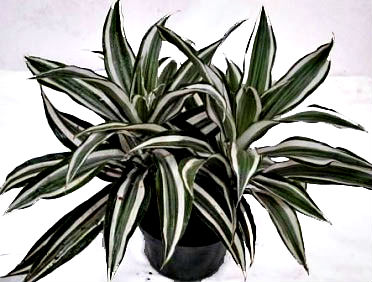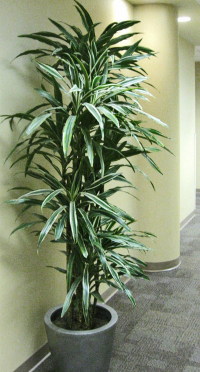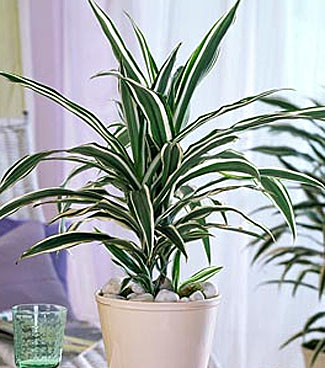Plant Care - Dracaena Warnecki
"Dracaena is a large family of plants that are very popular because they're hardy specimens that adapt to most home or office environments without a complaint.Grow them in our hydroponic system and they're almost indestructable!

Dracaena Warnecki has large, dark green leaves that are accented with white stripes, making this an attractive plant in any setting. A favorite in homes and offices because they're reliable growers with minimal care.
In our Hydroponic system, Dracaena Warnecki is an easy indoor plant to grow because they don't ask for much. They flourish in low light and don't want a lot of attention. They actually thrive on neglect!
The biggest problem caring for these plants is over doing it. Growing in soil, that usally means too much water. it's impossible to tell what's going on down inside the pot and overwatering is common (the #1 killer of indoor plants). These plants don't like wet feet and roots decay quickly in soggy, wet soil.
Growing is easy in our hydroponic system. There's never a problem with root rot or decay when growing in LECA pebbles. Air moves easily through the culture pot and around the roots, creating a strong root system. Strong roots mean healthy plants. The water gauge tells you when to water (or, more importantly, when NOT TO WATER). Most Dracanea Warnecki's growing in our system need watering only once every 3-4 weeks!
Great for people who travel!
Dracaena Warnecki come in several different shapes.
 Drac. Warnecki Cane Drac. Warnecki Cane |
 Drac. Warnecki Table Top size Drac. Warnecki Table Top size |
| Plant Care Growing with Hydroponics | ||
| Light: | Dracaena
Warnecki's are a very good low light plant. That means avoid direct
sun. Low light plants always grow better in Hydroponics because of improved air circulation at the roots. |
|
| Water: | Dracaena
Warnecki's don't like wet feet. Water to 1/2 on gauge. When the water gauge to read "Min" wait another 7-10 days before rewatering. Just like any other low light plant, it's imperative to allow for a dry period between waterings. Most Warnecki's need water only once every 3-4 weeks. |
|
| Temperature: | Keep
them warm - never go below 55 degrees. Leaves that turn black
are signs of cold damage. |
|
| What to Watch for: | Although
these plants resist most insects, be on the lookout for an ocassional
mealy bug. If lower leaves turn yellow faster than new growth appears, you're probably too generous with the water. Allow for more time between waterings. |
|

